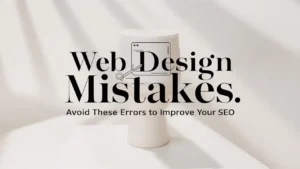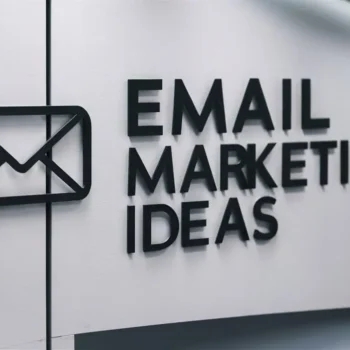Web Design Mistakes: Avoid These Errors to Improve Your SEO

In the competitive world of online marketing, a well-designed website is crucial. However, even the most visually appealing sites can fall short if certain web design mistakes are made. These errors can negatively impact your search engine optimization (SEO) efforts, making it harder for your site to rank high in search engine results. Understanding and avoiding these web design mistakes is essential for any business looking to improve its online presence.
Common Web Design Mistakes That Harm SEO
1. Slow Loading Times
One of the most critical web design mistakes is slow loading times. Websites that take too long to load can frustrate users and lead to high bounce rates. Search engines like Google consider page speed as a ranking factor, meaning slower sites are likely to rank lower in search results. Therefore, it’s essential to optimize your site’s speed to improve user experience and SEO.
2. Poor Mobile Optimization
With the majority of internet users accessing websites via mobile devices, it’s essential that your site is mobile-friendly. Poor mobile optimization can lead to a negative user experience and significantly harm your SEO. Ensure your website is responsive and provides a seamless experience across all devices. This will not only improve user satisfaction but also boost your rankings on mobile search results.
3. Overuse of Flash
While Flash can add interactive elements to your site, it can also be detrimental to your SEO. Search engines struggle to crawl Flash content, meaning essential information might not be indexed. Instead, opt for HTML5 and CSS3 to create interactive and SEO-friendly designs. This will help make your site more accessible to search engines and users alike.
4. Large Image Files
High-quality images are essential for a visually appealing website, but large image files can slow down your site. Compress images to reduce their size without sacrificing quality to improve loading times and enhance SEO. Using tools like TinyPNG or JPEG-Optimizer can help you achieve this balance effectively.
5. Lack of Alt Text for Images
Images without alt text are a missed SEO opportunity. Alt text helps search engines understand what the image is about, improving your site’s visibility in image search results. Ensure every image on your site has descriptive and keyword-rich alt text to enhance accessibility and SEO.
6. Complicated Navigation
User-friendly navigation is critical for both SEO and user experience. Complicated or unclear navigation can lead to high bounce rates as users struggle to find the information they need. Keep your navigation simple and intuitive to ensure users can easily find their way around your site. This will help keep them engaged and reduce bounce rates.
7. Not Using Headings Properly
Headings (H1, H2, H3, etc.) are essential for organizing content and helping search engines understand the structure of your site. Failing to use headings properly or overusing H1 tags can confuse search engines and negatively impact your SEO. Use headings to create a clear hierarchy of content, making it easier for both users and search engines to navigate your site.
8. Duplicate Content
Duplicate content confuses search engines and can lead to penalties, hurting your SEO efforts. Ensure all content on your site is unique and valuable to avoid being flagged for duplication. Regularly audit your site to identify and remove any duplicate content, ensuring that each page offers something new and useful to visitors.
How to Avoid Web Design Mistakes
1. Prioritize Page Speed
Use tools like Google PageSpeed Insights to monitor and improve your website’s loading times. Optimize images, leverage browser caching, and minimize CSS and JavaScript files. These steps will help ensure your site loads quickly and efficiently, enhancing both user experience and SEO.
2. Optimize for Mobile
Implement responsive design techniques to ensure your site looks and functions well on all devices. Test your site on various mobile devices to identify and fix any issues. This will help you provide a seamless experience for all users, regardless of the device they are using.
3. Use Modern Web Technologies
Replace Flash with modern web technologies like HTML5 and CSS3. These technologies are more SEO-friendly and improve the overall performance of your site. By using the latest web standards, you can ensure your site is accessible and easy to crawl for search engines.
4. Compress Images
Utilize tools such as TinyPNG or JPEG-Optimizer to compress images without losing quality. This will help improve your site’s loading times and SEO. By reducing the size of your image files, you can make your site faster and more efficient.
5. Add Descriptive Alt Text
Ensure every image on your site includes descriptive alt text. This not only helps with SEO but also makes your site more accessible to users with visual impairments. By providing detailed descriptions of your images, you can improve your site’s accessibility and search engine visibility.
6. Simplify Navigation
Design your site with user experience in mind. Keep navigation menus simple, and ensure users can easily find what they’re looking for. This will help keep users engaged and reduce bounce rates, which can positively impact your SEO.
7. Use Headings Correctly
Use headings to structure your content logically. Ensure each page has one H1 tag and use H2 and H3 tags for subheadings. This will help search engines understand the structure of your content and improve your site’s SEO.
8. Ensure Unique Content
Regularly audit your content to ensure it is unique. Use tools like Copyscape to check for duplicate content and make necessary adjustments. By providing unique, valuable content, you can improve your site’s SEO and provide a better experience for your users.
Conclusion
Avoiding common web design mistakes is crucial for improving your SEO and enhancing the overall user experience. By prioritizing page speed, optimizing for mobile, using modern web technologies, compressing images, adding descriptive alt text, simplifying navigation, using headings correctly, and ensuring unique content, you can create a website that not only looks great but also ranks well in search engine results. For more tips on improving your website’s SEO, check out our other resources on web design and SEO best practices.


